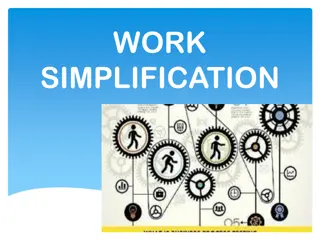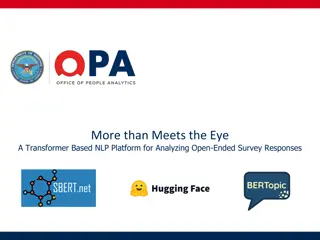The SP System: Simplification, Integration, and Potential Applications in Defense
The SP system, based on the theory of intelligence, focuses on simplifying and integrating concepts in artificial intelligence. By utilizing multiple alignment concepts borrowed from bioinformatics, the SP system shows promise in solving various challenges in AI. Its SP-neural mapping and comparisons with other AI systems highlight its advantages, particularly in addressing deep learning issues. The system's versatility and adaptability underscore its potential applications in defense and related fields.
Download Presentation

Please find below an Image/Link to download the presentation.
The content on the website is provided AS IS for your information and personal use only. It may not be sold, licensed, or shared on other websites without obtaining consent from the author. Download presentation by click this link. If you encounter any issues during the download, it is possible that the publisher has removed the file from their server.
E N D
Presentation Transcript
THE SP SYSTEM AND ITS POTENTIAL APPLICATIONS IN DEFENCE Dr Gerry Wolff CognitionResearch.org
THE SP SYSTEM Very roughly, the SP theory of intelligence (expressed in the SP computer model) is: A database system... with intelligence. CognitionResearch.org
SIMPLIFICATION AND INTEGRATION possibilistic logic neural networks prototype theory simulated annealing semi graphoid temporal logic Computer science, including artificial intelligence, has become very fragmented. Horn clause tableau LL(k) grammar Lisp inheritance schema variable constraint satisfaction inductive logic programming pushdown automaton Petri nets operator situation calculus fuzzy logic truth maintenance object oriented design The SP system aims to simplify and integrate observations and concepts in AI and related areas . Skolemization genetic algorithm lambda calculus explanation based learning write rule Bayesian networks case based reasoning logic programming organising feature maps blackboard autoepistemic logic expert system means ends analysis production systems utility theory perceptron ontologies parsing tuple The key to simplification and integration is the multiple alignment concept (next). CognitionResearch.org
MULTIPLE ALIGNMENT: A CONCEPT BORROWED (AND ADAPTED) FROM BIOINFORMATICS Stretching of sequences in a computer brings matching letters into line. Heuristic methods are needed because the search is complicated. CognitionResearch.org
AN SP MULTIPLE ALIGNMENT SP-multiple alignment is central in the SP system. The versatility of SP-multiple alignment (described later) is a major discovery. SP-multiple alignmentcould be the double helix of intelligence. CognitionResearch.org
SP-NEURAL Concepts in the SP system may be mapped into SP-neural, meaning the SP theory expressed as neurons and their inter- connections. CognitionResearch.org
COMPARISON WITH OTHER AI-RELATED SYSTEMS A recent paper describes several advantages of the SP system compared with several AI-related alternatives. There are at least 14 problems with deep learning which are solved in the SP system. CognitionResearch.org
VERSATILITY AND ADAPTABILITY OF THE SP SYSTEM Unsupervised learning: a foundation for all other kinds of learning. Representation of several different kinds of knowledge. Several different kinds of reasoning. Pattern recognition and computer vision: Robust in the face of errors in data; At multiple levels of abstraction. Processing of natural language. Information storage and retrieval. Planning a route between two places. Solving the kinds of problem used in IQ tests. CognitionResearch.org
SEAMLESS INTEGRATION IN THE SP SYSTEM SP-multiple alignment has potential to be a universal framework for diverse kinds of knowledge (DK) and diverse aspects of intelligence (DI). This gives the SP system potential for the seamless integration of DK and DI (SIDKDI). SIDKDI appears to be essential if we are to achieve human-like fluidity, versatility and adaptability in artificial intelligence. For example, in solving whodunnit problems, detectives naturally make use of many different kinds of knowledge and many different aspects of intelligence. CognitionResearch.org
A HIGH-PARALLEL SP MACHINE AS A STEP TOWARDS AN INDUSTRIAL-STRENGTH SYSTEM, AND AS A VEHICLE FOR RESEARCH CognitionResearch.org
THE POTENTIAL OF THE SP SYSTEM IN DEFENCE SUMMARY The SP system as a versatile database system, with intelligence. Helping to solve nine problems with big data. Helping to develop human-like intelligence in autonomous robots. Unsupervised learning. Several kinds of reasoning. Planning and problem solving. Pattern recognition and computer vision. Processing of natural languages. The detection and management of errors in data. Data fusion. Transparency and visualisation. CognitionResearch.org
THE SP SYSTEM AS A VERSATILE DATABASE SYSTEM, WITH INTELLIGENCE Storage of information Efficiency in the use of storage space. Efficiency in the transmission of information. Retrieval of information Query-by-example. Natural language queries. SQL. Versatility in representing different kinds of knowledge and with different aspects of intelligence. Seamless integration of different kinds of knowledge and different aspects of intelligence. CognitionResearch.org
BIG DATA The SP system can help solve nine problems with big data: Overcoming the problem of variety in big data. The unsupervised learning or discovery of natural structures in data. Interpretation of data: pattern recognition etc. Velocity: analysis of streaming data. Volume: making big data smaller. Model-based coding: additional economies in the transmission of data. Energy, speed, and bulk. Veracity: managing errors and uncertainties in data. Visualisation: knowledge structures and processing. CognitionResearch.org
HELPING TO DEVELOP HUMAN-LIKE INTELLIGENCE IN AUTONOMOUS ROBOTS Human-like versatility in skills may be developed via unsupervised learning in the SP system. This contrasts with bespoke software for each skill. Parallel processes may be managed via two-dimensional patterns in the SP system. CognitionResearch.org
UNSUPERVISED LEARNING The SP system has strengths and potential in unsupervised learning (the inspiration for the system). It means learning without a teacher or anything equivalent. Most human learning is unsupervised. It is the foundation for reinforcement learning , learning by imitation , learning by being told , and more. For defence, it can mean: The discovery of significant structures, patterns, or associations in data. Automatic or semi-automatic organisation of unstructured or semi- structured information. CognitionResearch.org
SEVERAL KINDS OF REASONING, WITH OTHER ASPECTS OF INTELLIGENCE The SP system supports several kinds of reasoning that can work together and with other aspects of intelligence (such as planning and problem solving), in any combination. This is a major strength of the system. For defence, this can mean: Helping to anticipate and head off acts of terrorism. Helping to work out the possible implications of knowledge about an enemy. Helping to develop military strategies and tactics. CognitionResearch.org
PATTERN RECOGNITION AND COMPUTER VISION The SP system has strengths and potential in: Recognising patterns in data, including such things as patterns of activity, or language styles, that have been previously learned by the system. Recognising or retrieving such things as finger prints or DNA samples that are the same as or similar to a given target. Computer vision: analysis and interpretation of scenes, recognition of people from different angles, recognition of objects and their significance, . CognitionResearch.org
PROCESSING OF NATURAL LANGUAGE The SP system has strengths and potential in: Parsing (analysis) and production of natural language without meanings. Understanding natural language and production of language from meanings. Translation between natural languages via meanings. Potential applications in defence, include understanding conversations by suspects, understanding legal documents, and help in composing reports. Seamless integration of NL with other aspects of intelligence. More ambitious than NL in current AI applications. CognitionResearch.org
THE DETECTION AND MANAGEMENT OF ERRORS IN DATA Pattern recognition and learning are robust in the face of errors in data. This allows the system to detect errors in data, including errors from deception. CognitionResearch.org
DATA FUSION Streams of information from two or more sensors often need to be combined into a coherent whole. This can be done if each stream contains information, such as the time of each reading, which can be matched with corresponding information in other streams. That kind of matching and merging of information is what the SP system does. CognitionResearch.org
TRANSPARENCY AND VISUALIZATION In the SP system there is transparency in: How knowledge is organised (cf deep learning and artificial neural networks). Processing there is an audit trail for all processing. Static and moving graphics may help visualisation of knowledge and processing. This is likely to be important in: Assessments of security against crime or terrorism. Legal issues arising from crime or terrorism. CognitionResearch.org
FURTHER INFORMATION www.cognitionresearch.org/sp.htm . Papers: There are details of several papers, many with download links, on the above web page. Contact: jgw@cognitionresearch.org, +44 (0) 1248 712962, +44 (0) 7746 290775. CognitionResearch.org























